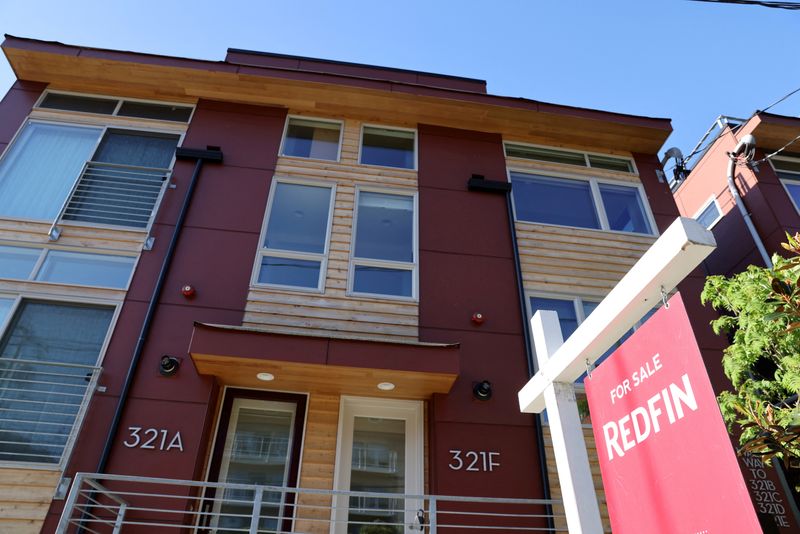By Lucia Mutikani
WASHINGTON (Reuters) - U.S. existing home sales fell for a third straight month in May as record-high prices and a resurgence in mortgage rates sidelined potential buyers from the market.
There was, however, some encouraging news on the housing market, with the National Association of Realtors reporting on Friday that housing inventory jumped last month to the highest level in nearly two years. Rising supply, if sustained, could curb further price gains and improve affordability.
Nonetheless, weak home sales added to a sharp drop in housing starts and building permits last month in suggesting that a re-acceleration in mortgage rates from April through May had sapped momentum from the housing market recovery.
"Poor affordability and still-low, though rising listings in the resale market are keeping buyers at bay, with little change expected until the Federal Reserve reduces policy rates," said Sal Guatieri, a senior economist at BMO Capital Markets.
Home sales dropped 0.7% last month to a seasonally adjusted annual rate of 4.11 million units. Economists polled by Reuters had forecast home resales sliding to a rate of 4.10 million units. Home resales, which account for a large portion of U.S. housing sales, decreased 2.8% year-on-year in May.
The average rate on the popular 30-year fixed mortgage raced to a six-month high of 7.22% in early May before retreating to just below 7.0% by the end of the month, data from mortgage finance agency Freddie Mac showed.
The Federal Reserve has maintained its benchmark overnight interest rate in the current 5.25%-5.50% range since last July. The U.S. central bank has hiked its policy rate by 525 basis points since March 2022. Residential investment scored double-digit growth in the first quarter, but is on course to subtract from gross domestic product this quarter.
Sales dropped 1.6% in the densely populated South. They were unchanged in the Midwest, which is considered the most affordable region, as well as in the Northeast and West.
Housing inventory increased 6.7% to 1.28 million units last month, the highest since August 2022. Supply jumped 18.5% from one year ago. NAR chief economist Lawrence Yun noted that inventory vaulted 40-60% in Texas and Florida, which he partially attributed to soaring costs like property insurance.
Homeowners nearly across the country have seen a surge in insurance premiums amid rising claims, some related to flooding and wildfires.
But entry-level homes remain scarce, with sales of properties under $250,000 continuing to slump year-on-year.
At May's sales pace, it would take 3.7 months to exhaust the current inventory of existing homes, up from 3.1 months a year ago. A four-to-seven-month supply is viewed as a healthy balance between supply and demand.
The PHLX housing index fell, underperforming in a mostly higher stock market. The dollar rose against a basket of currencies. U.S. Treasury yields dipped.
MULTIPLE OFFERS LINGER
Despite the improvement in supply, the median existing home price surged 5.8% from a year earlier to an all-time high of $419,300. The percentage increase was the largest since October 2022. Most of the homes sold last month cost $750,000 or more.
About 30% of the houses were sold above the listing price, indicating that multiple offers remain in some areas. Home prices increased in all four regions.
"There might be some suggestion that high prices are bringing more listings onto the market," said Conrad DeQuadros senior economic advisor at Brean Capital. "Housing is not likely to be the driver of the macro economy in the months ahead."
Properties typically stayed on the market for 24 days in May, up from 18 days a year ago.
First-time buyers accounted for 31% of sales, compared to 28% a year ago, remaining below the 40% that economists and realtors say is needed for a robust housing market.
All-cash sales made up 28% of transactions, up from 25% a year ago. Distressed sales, including foreclosures, represented only 2% of transactions, unchanged from last year.
While the housing market has hit a rough patch, the broader economy continues to chug along amid signs that inflation is cooling after heating up in the first quarter.
A survey from S&P Global on Friday showed its flash U.S. Composite PMI Output Index, which tracks the manufacturing and services sectors, nudged up to 54.6 this month.
That was the highest level since April 2022 and followed a final reading of 54.5 in May. A reading above 50 indicates expansion in the private sector. Both the services and manufacturing sectors contributed to the gain in activity.

The pace of increase in input prices slowed as did the rate at which businesses are raising prices for goods and services.
"Slow-and-steady economic growth is consistent with expectations for the Fed to begin cutting interest rates gradually in the second half of 2024," said Bill Adams, chief economist at Comerica (NYSE:CMA).